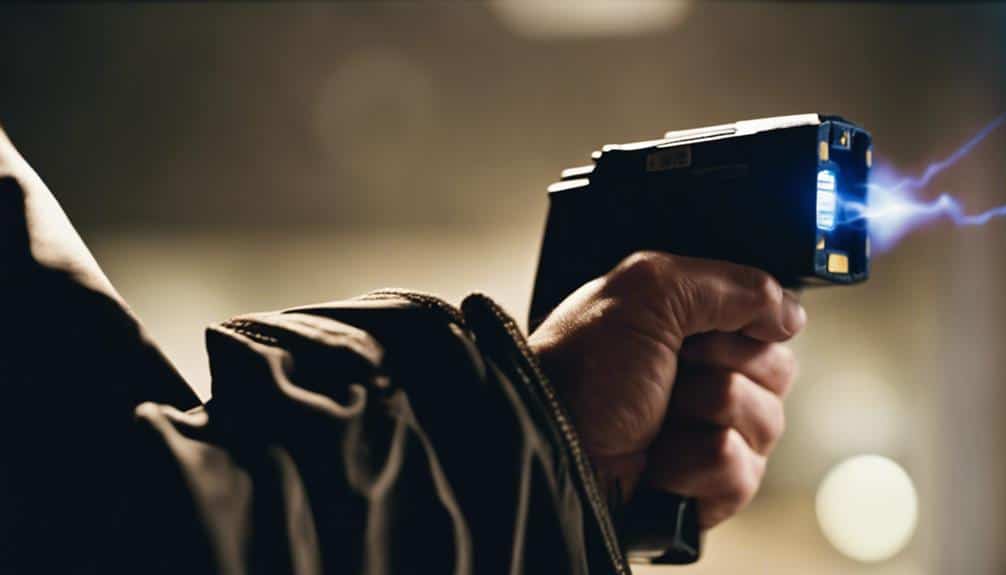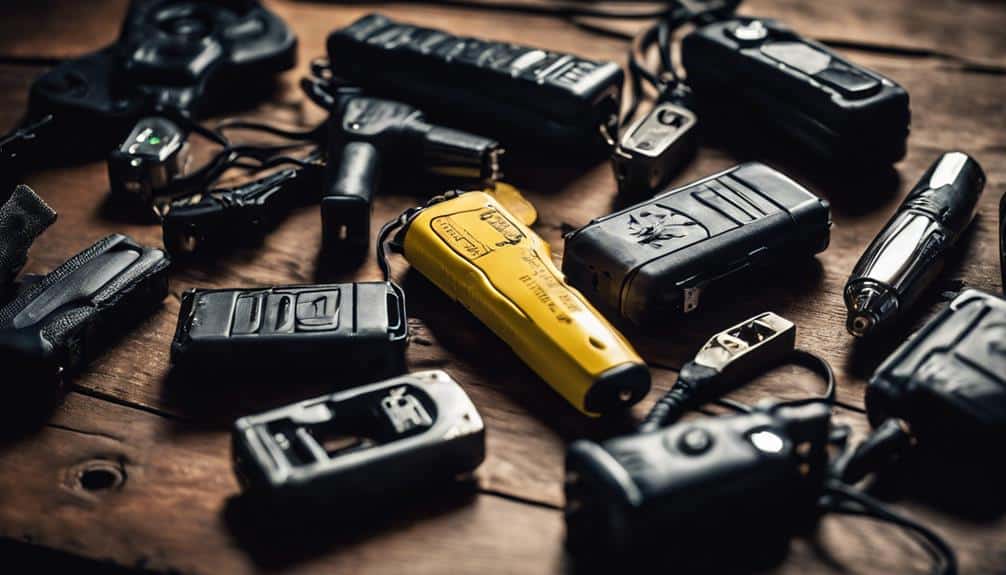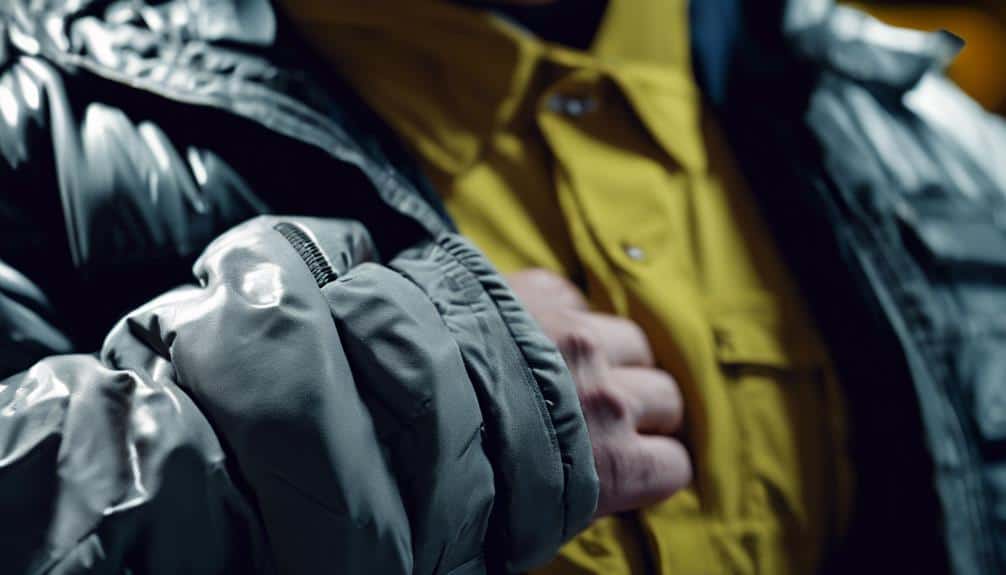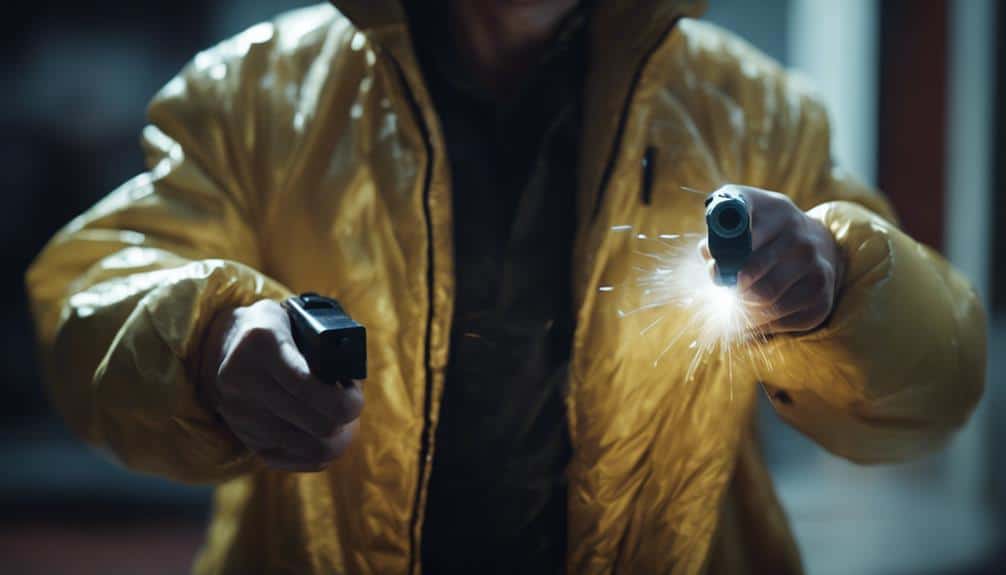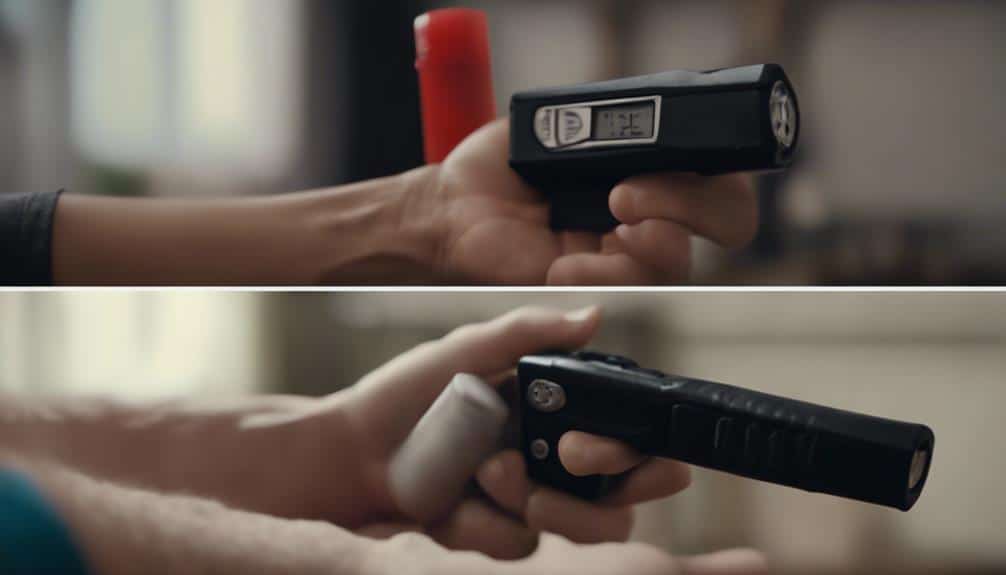Yes,
stun guns do work through clothes! They deliver a high-voltage, low-amperage shock that can penetrate most common fabrics, like cotton or polyester, fairly easily. However, thicker materials like denim or leather might reduce their effectiveness, so it’s always best to aim for large muscle groups like the shoulders, chest, or back where clothing is thinner. Need a little humor? Think of them as the ultimate bad-hair-day creators, but for your muscles. For maximum effectiveness, maintaining contact for at least three seconds is key. Curious about the best types of stun guns or how to maximize your self-defense strategies? You’re in for some valuable insights.
Understanding Stun Guns
To understand
stun guns, you need to know that they deliver
high-voltage,
low-amperage electrical charges to disrupt
muscle functions and
incapacitate attackers temporarily.
These devices pack quite a punch, with voltages ranging from 50,000 to 300,000 volts, enough to override your attacker’s nervous system, causing involuntary muscle contractions and rendering them immobile for a few vital moments.
When it comes to effectiveness, the type and thickness of clothing can make a big difference. A high-voltage stun gun is more likely to penetrate common clothing materials, like a hoodie or a light jacket, compared to its low-voltage counterparts.
However,
direct contact with the skin is always the best bet for maximum impact. Think of it as trying to water a plant; the closer you are, the better the results.
Targeting
large muscle groups, such as the shoulders or back, is essential. These areas not only provide larger surfaces but are often less shielded by thick clothing.
How Stun Guns Work
A stun gun works by delivering a high-voltage, low-amperage electrical charge that disrupts muscle function and incapacitates an attacker temporarily. When you use a stun gun, it sends an effective charge through the body, causing muscle disruption that leaves the attacker unable to control their movements.
Think of it this way:
- High-voltage models: These can penetrate common clothing types effectively, ensuring that even if your assailant is wearing a jacket, they’ll still feel the impact.
- Clothing thickness matters: The thicker the fabric, the more powerful the charge needed. A winter coat may require a stronger stun gun to deliver an effective charge.
Types of Stun Guns
Stun guns come in several types, each tailored for different
self-defense needs and preferences. Whether you’re looking for something compact or multifunctional, there’s a stun gun that fits your lifestyle perfectly.
First off, the
mini stun gun is a fantastic choice for those who want effective self-defense tools that are easy to carry. These little powerhouses pack a punch despite their size, making them ideal for
close-proximity situations.
Then there’s the
flashlight stun, which combines a bright light with a shocking surprise—perfect for those dark, scary parking lots. It’s like having a two-for-one deal on peace of mind!
Baton stun guns take it a step further by offering both a striking weapon and an electric shock. Imagine you’re a Jedi, but with a baton that can zap!
On the other hand,
Taser devices are more like
long-range tasers, using barbed probes to immobilize assailants from a distance. These are especially helpful when you can’t or don’t want to get up close and personal.
Each type has its unique advantages, but all are designed to be effective self-defense tools, regardless of clothing and skin barriers.
Effectiveness Through Clothing
Understanding how stun guns perform through clothing is key to guaranteeing you choose the right tool for your self-defense needs. Stun guns can be quite effective even when your attacker is wearing clothes. However, the type and thickness of the clothing can impact how well the electric shock penetrates.
Light fabrics pose less resistance, allowing high-voltage models to deliver a charge with ease. But when it comes to thicker clothing, you’ll need a more powerful stun gun to confirm the charge is effective.
Here’s what you need to take into account:
- Light fabrics: Stun guns can deliver a shock through common clothing types like t-shirts and sweatshirts.
- Thicker clothing: Materials like denim and leather can reduce the effectiveness of the charge, requiring a stronger stun gun.
To maximize the stun gun’s effectiveness, aim for sustained contact of at least three seconds. This increases the likelihood of the charge penetrating clothing and delivering the intended electric shock.
Target Areas
When using a
stun gun, aim for
large muscle groups like the shoulders, back, and chest to maximize its
effectiveness. These areas are prime targets because they provide better conductivity for the
electrical charge, increasing the chances of
incapacitating the attacker. Targeting large muscle groups between the neck and waist heightens the likelihood of electrical disruption, making these zones especially vulnerable.
Heavy clothing can complicate things, though. Thicker materials might reduce the stun gun’s effectiveness, so aim for areas with less clothing thickness for ideal charge delivery. If you can, go for
direct skin contact, as it greatly enhances the stun gun’s impact. Envision trying to shock someone through a winter coat—it’s just not going to pack the same punch as hitting a t-shirt-clad shoulder.
Proper training is essential. Understanding where to aim means you can act quickly and efficiently in a tense situation. Visualize this: You’re in a
dimly lit parking lot, and someone approaches menacingly. Knowing to aim for their chest or back can make all the difference in incapacitating the attacker and ensuring your safety.
Duration of Application
While targeting large muscle groups is key, the duration of application also plays a critical role in a stun gun’s effectiveness. You need to maintain contact for a specific period to guarantee the charge passes through the attacker’s body, causing incapacitating muscle contractions.
A brief 0.5-second jolt might startle, but it’s not enough to stop someone. Instead, aim for a 3 to 5-second burst for maximum effectiveness, which increases the chances of disorienting and incapacitating the attacker.
Here’s the breakdown:
- 0.5-second jolt: Causes a painful shock, but the attacker can still function.
- 1 to 2 seconds: Leads to muscle spasms and a dazed state, giving you a momentary advantage.
If the attacker is wearing thicker clothing, sustain the contact longer to guarantee the charge penetrates effectively. You want to make certain the electrical charge reaches those large muscle groups and disrupts their function.
Safety Measures
Always confirm your
stun gun is in
good working condition by regularly inspecting it for any
signs of damage. Cracks or other issues can compromise its effectiveness and your safety. Stun guns must be maintained properly to guarantee they work when you need them most. Regular checks can mean the difference between a device that protects you and one that fails at a critical moment.
Safety measures don’t stop at inspection. Understanding how
clothing penetration affects performance is key. While stun guns can penetrate common clothing, the thickness and material matter.
High-voltage stun guns are generally better at overcoming thicker fabrics, but aiming for areas with less clothing thickness, like the shoulders or upper body, provides better contact. This maximizes the charge delivery, even through layers.
Direct contact with the skin is vital for peak performance. Low amperage stun guns rely on
sustained contact to transmit a successful shock through clothing. So, in a
self-defense situation, make sure to aim for spots where the fabric is thinner or even exposed skin, if possible. These safety measures make certain you’re prepared and your stun gun is up to the task, providing peace of mind and
effective protection.
Legal Considerations
Before you run out and buy a stun gun, make sure you’re up to speed on the
local laws; some places treat them like just another
self-defense tool, while others have strict regulations or outright bans.
You might need a permit or have to meet certain age requirements, typically 18, but checking your specific area’s rules is essential.
And remember, no matter where you are, bringing a stun gun into restricted places like schools or airports is a fast track to
legal trouble!
Regional Ownership Laws
Understanding the regional ownership laws for stun guns is essential, as legality can vary widely depending on where you live. Stun gun ownership can be a bit of a legal maze, especially since these self-defense weapons are highly effective but also highly regulated. It’s important to know the local laws to avoid any legal repercussions.
Here are a few things to keep in mind:
- State Restrictions: Some states, like Hawaii and Rhode Island, completely prohibit stun guns, making ownership illegal.
- Local Ordinances: Even within states, cities might have their own rules. For example, a stun gun might be legal in one part of California but restricted in another.
Checking regional ownership laws is your first step. Some areas may require a carry permit to legally possess and use a stun gun. Ignoring these laws can lead to significant legal repercussions, including fines or even criminal charges.
Age and Permit Requirements
Maneuvering age and
permit requirements for
stun gun ownership can be tricky, so it’s vital to know your
local laws. In most U.S. states, you need to be at least 18 to own a stun gun, but some areas impose stricter
age requirements. For instance, while many places keep it simple, others might throw a curveball by requiring a
background check or a permit.
So, before you think about adding a stun gun to your self-defense arsenal, make sure you verify your local laws.
The
legal landscape of stun gun ownership can be a bit like traversing a maze. Some states, like Hawaii and Rhode Island, outright ban stun guns. Meanwhile, other regions may allow them but have specific regulations about where you can carry them—public areas, schools, or government buildings often have restrictions.
Understanding these ownership laws is vital for
responsible ownership. You don’t want your
self-defense weapon to land you in hot water!
Knowing the regulations guarantees you’re compliant and prepared to use your stun gun safely and legally. After all, responsible ownership means being informed and ready to defend yourself without any legal hiccups.
Alternatives to Stun Guns
When considering alternatives to stun guns, pepper spray stands out as an effective and widely legal option for self-defense. Unlike stun guns, which require close contact, pepper spray allows you to maintain a safe distance from an attacker. It’s legal in all 50 states, making it a versatile self-defense product that you can carry almost anywhere without worrying about legal restrictions. Law enforcement officers often recommend it as a powerful self-defense tool.
But that’s not all. You’ve got more options in your self-defense toolkit:
- Keychain weapons: These handy gadgets enhance your hand strikes and are perfect for everyday carry. Imagine having a powerful self-defense tool right on your keychain!
- Personal alarms: These small devices emit loud noises to distract potential attackers and alert bystanders. It’s a non-physical means of defense, perfect for those who prefer to avoid direct confrontation.
Incorporating these alternatives to stun guns into your safety routine can provide peace of mind and enhance your overall security.
Frequently Asked Questions
How Much Clothing Can a Taser Penetrate?
You’ll find stun gun effectiveness varies with clothing thickness impact. Thinner fabrics offer less resistance, enhancing performance. Taser range limitations and environmental factors influence results. Follow stun gun safety guidelines for ideal use, considering clothing material resistance.
What Clothing Stops a Taser?
To stop a Taser, focus on clothing thickness and fabric type. Layering effects, material conductivity, and clothing insulation play roles. Tactical gear often provides better protection methods, making it harder for the electrical charge to penetrate.
Does a Stun Gun Penetrate the Skin?
When a stun gun penetrates the skin, its effectiveness increases due to lower skin resistance and higher electrical conductivity, enhancing pain perception and muscle reaction. For self-defense strategies, always follow safety precautions to maximize the device’s impact.
You should know stun gun legality varies. Check state laws on self-defense tools, as weapon regulations differ. Concealed carry in public spaces might be restricted. Always verify local rules for personal safety and avoid legal issues.




